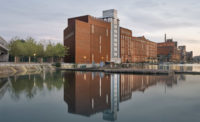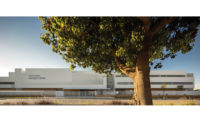Jacques Herzog on Mixing Tenses
The Swiss architect talks about his firm's take on reworking the past.
 |
| Jacques Herzog |
| Photo © Georg Gatsas |
The following excerpts are from a conversation included in Park Avenue Armory, a limited-edition publication edited by Gerhard Mack for the Park Avenue Armory Conservancy.
Gerhard Mack: Working with existing volumes is seminal to your work. Your career actually started in the late 1970s with various refurbishment projects. But you did it in a way that was different from Postmodernism's schematic reaction to Modernism's permanent call for something new.
Jacques Herzog: Our early refurbishment projects really were pragmatically motivated. In the second half of the 1970s, Modernism suffered from a major economic recession, followed by an oil crisis, and the realization that resources are not unlimited. Renovation was almost the only available work, and could be applied to regular buildings that were not necessarily of great historical significance. Modernism had thought of history as an impediment to the goal of creating a new tradition, a new future, a new society. But as a result of the crisis, the advisability of sweeping everything away'creating a tabula rasa'was questioned. If we had been born ten years earlier, we would have been more profoundly influenced by a still-intact Modernism. But as it was, this historical break enabled us to develop our own issues.
GM: How would you describe your approach in general?
We make people aware of what is already there: the form that we produce brings out the properties and qualities of the world around it.
GM: The Museum der Kulturen in the Old Town of Basel shows how you incorporate existing environs into your design. How did you go about giving the building a new visibility?
To begin with, we turned the previously neglected courtyard in the back into the new entrance. This reversal unites medieval buildings with the rear facades of 19th-century buildings, and we wanted people to experience this area as a space where various components are interrelated. Then we lowered the courtyard so that it is now level with the lowest story of the museum. When you enter the courtyard, you don't have to decide whether to go up or down. Second, we used plants to unify the surfaces in the courtyard. They come as a surprise; they look exotic; and since they change with the seasons, there is also something temporary and fragile about them. And so there was no need to make any major modifications in the buildings.
GM: You also replaced the roof of the museum.
Our initial mandate was to plan an exhibition space for temporary presentations. We placed this extension on the roof and deliberately made it clearly visible from outside to draw attention to the museum's new entrance. At the same time, we wanted to integrate the new roof into the existing roofscape. That's why we covered it with glazed tiles, similar to those already used in the historical context. On one hand, it's an invasive modification, and on the other, it's an almost tender gesture because it resonates with the shapes and materials of the Old Town.
GM: Is the substance of the building a kind of ping-pong partner that you use to bat your ideas back and forth as they develop?
Ping-pong sounds a little frivolous. But we do, of course, go back and forth, thinking about what to preserve and what to tear down. If that weren't the case, it would mean returning to an approach that breaks off the process before it's been thought through. That doesn't mean that we love it, but we have accepted it as the material of our work.
GM: Your inserts are spaces of absence that brilliantly leave room for a host of ideas about presence, history, and interpretation. Does that imply a certain critique of society?
In our society, the interplay of what exists and what is new has become extremely convoluted. It is easier to pursue particular interests when things can't be distinguished, when issues are blurred, as they are, for instance, in referendums. This applies even in such a small, straightforward country like Switzerland. In architecture, we always take the singular building seriously as part of a larger fabric, as part of daily life that involves the participation of many people.
GM: You work with what exists and exploit its energy. In the case of the Park Avenue Armory, you practically fade into the wallpaper of the building's history. You opted for a microsurgical approach diametrically opposed to the way monuments are ordinarily reconstructed in the United States.
The Armory is a stunning memorial to American history. In the period rooms, you walk into sacred territory'the creations of the best designers that were to be had in those days. It would be utterly inappropriate for us to force a contemporary spirit on such a monument.
We wanted to revitalize the original concept of these rooms, which cannot be found anywhere else. In this case, consideration and respect have priority over making an authorial statement. Incidentally, simulative, reconstructive models and total restoration are not mutually exclusive, although the complete restoration of a whole room is of no interest to us as architects.
GM: Even in New York, a city of permanent renewal, the Holy Grail of Modernism, you have reacted with almost 'unmodern' delicacy and discrimination.
New York is no longer a city of permanent change and hasn't been for a long time. Because of our background, it has always been a crucial concern of ours to pay attention to what is already there'including Modernism. But that's not a moral motivation. It makes for better projects.
We have also begun working where there is nothing for us to tie in with, nothing to be preserved. In those cases, the tabula rasa is a promising strategy. But even in central Europe we have reached a point where there is just too much mediocrity. So we also explore the possibility of destruction instead of extension, in other words, an iconoclastic strategy, to find a new openness and new movement again. The methods may then be different from those of Modernism or from countries like China and India. Modernism wanted to manifest itself as an image, a style. We now try to look at a site from a different point of view, which means trying to institute change through a focus on perception.
Gerhard Mack is author of Complete Works for Herzog & de Meuron, four vols. (Birkhauser, 1993'2008).





